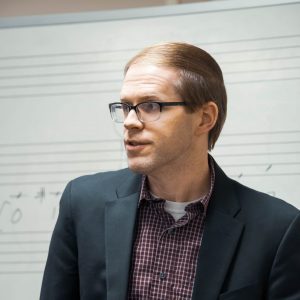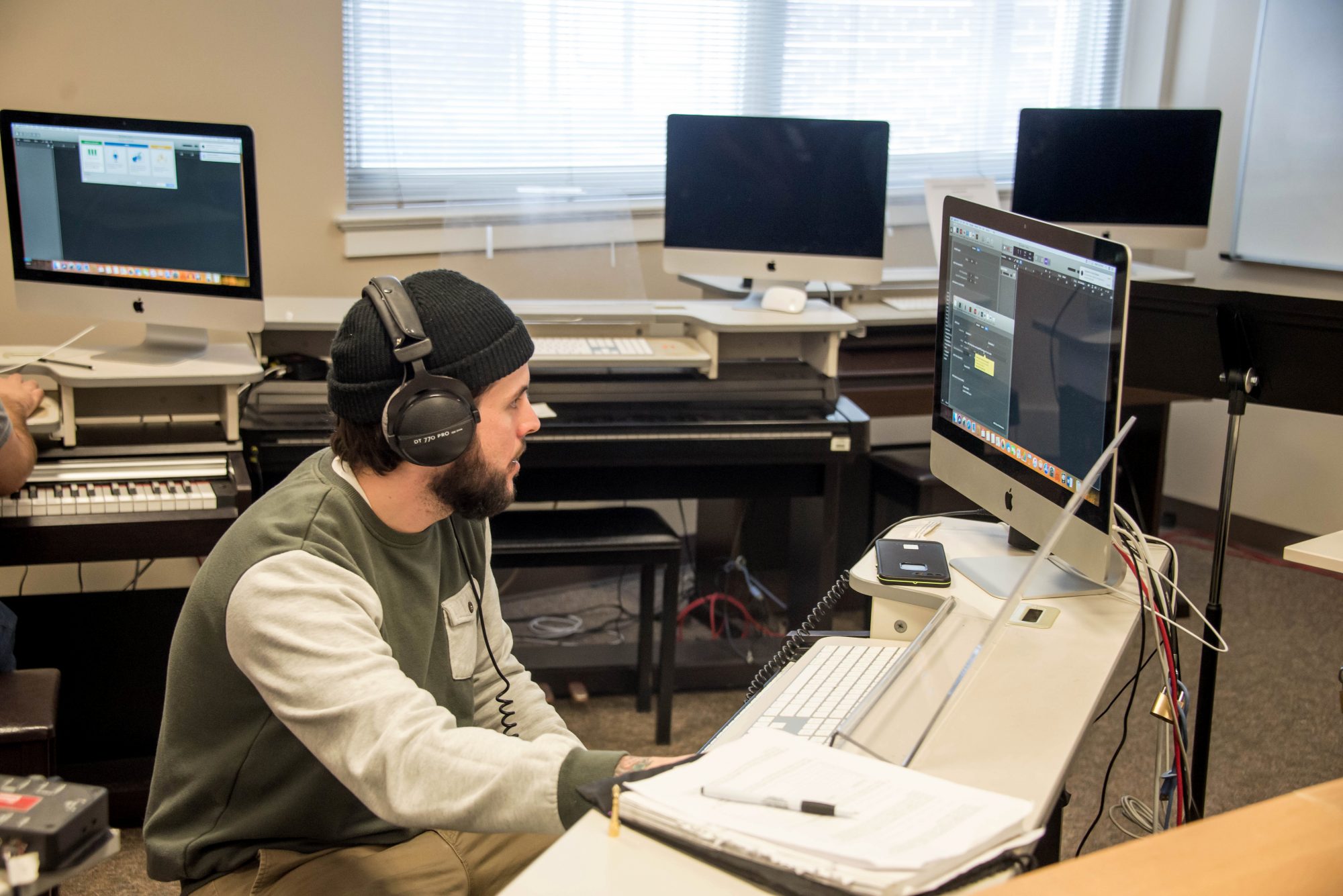Photo: Music composition major, Derek Summers, works in Finale on the first movement of his original composition, a violin, clarinet, and piano trio called Arcs.
The University Center for the Arts is alive with the sound of music, most of which was created with technology. From music and technology courses to music composition degrees to significant hardware and software technological upgrades, CSU students and UCA patrons are benefitting from the continued investment in music technology by the School of Music, Theatre, and Dance.
A brief history of music technology
Aside from centuries of instrument advancements, Dr. James David, associate professor of music; composition, calls recorded sound the ‘first big thing’ as far as the impact of technology on music. “A composer in Paris could suddenly hear musical styles and cultural influences from all over the world, and we immediately see a huge explosion in new ideas,” he explains.
The mid-century invention of the synthesizer and the process of connecting it to computers caused composers to recognize the similarity between computer language and music notation. The computer revolution surged again in the 1980s with Musical Instrument Digital Interface (MIDI), a protocol that furthered communication between computers and musical instruments, transforming how music is composed.
“It was the biggest shift in centuries,” states David about the technology that birthed the home recording studio and impacted genres of music, from rock to jazz to classical.
Starting with pencil and paper
Music technology labs have been a critical component of the University Center for the Arts since its opening in 2008, and equipment upgrades were completed last year with new iMacs outfitted with the composition software, Logic Pro, and Final Cut Pro.
Because electronic composing tools are readily available, it’s likely a composition major arrives on campus with software familiarity, however, without fully understanding the musical underpinnings, advancing with the tools is difficult. As such, David recommends a stripped back approach in the beginning. “I strongly encourage students to work with pencil and paper and acquire that physical understanding of musical notation as a language and a skill.” Therefore, first-year students only transfer phrases into the computer after writing the notes on paper.
As students progress through the program, they eventually work directly with music software during the composition process. “As the complexity of their compositions increase, it becomes too time-consuming to do by hand,” adds David.
Magical moments made possible by technology
Lead by David, a nationally renowned composer, CSU Music offers an undergraduate degree in music composition and a recently announced Master of Music in Music Education with a Composition Specialization, a hybrid graduate degree that is the only program of its type in the U.S.
A unique aspect of majoring in music at CSU involves hands-on experiences for composition and music education students. Each spring, the School of Music, Theatre, and Dance hosts the Middle School Outreach Ensemble (MSOE), a community-based music outreach program, now in its sixth year, where more than 60 music educators, including advanced high school students, college music majors, collegiate faculty, and practicing teachers, provide the instruction to 200 young instrumentalists.
In what is a two-year internship process under David’s supervision, student composers contribute original compositions for band and orchestra to the thirteen-week program, and quite a few of the new works have been electroacoustic pieces, an uncommon opportunity for middle school repertoire.
For instance, in 2017, Thomas Lack’s (B.M., ’17) 1990s drum-and-bass scene inspired piece “had the young musicians really excited as orchestra rarely references contemporary popular music,” says David.
As a supplement to the piece, Lack programmed loops for at-home use. “It was really cool,” exclaims Dr. Erik Johnson, music education professor and MSOE founder/coordinator. “We wanted the MSOE students to practice improvising around these loops that were like the music we were performing as a group.” As a direct result, students increased their musical fluency as they experimented with their instruments.
Exposing middle school students to music written by contemporary composers is a powerful and transformative experience in their early musical lives, especially when given the opportunity to meet the composers during the process. Dr. Johnson recalls a young flutist’s comment about a piece inspired by ‘Rosie the Riveter.’ “She was awed that not only was the piece written about a strong, powerful woman in American society but by a composer she got to interact with who was a strong, powerful woman as well,” he says.
Beyond the physical ability to play a piece, making music truly occurs when students understand what the piece is trying to express. “What better way to do that than to collaborate with the composer who is living and breathing right in front of them,” exudes Johnson. “This coming together for a common purpose embodies the mission of MSOE, and more broadly, the mission of music education: to allow art as music to facilitate our understanding of our place in a very complex world and music technology facilitates these magical moments!”

Dr. James M. David is an internationally recognized composer who currently serves as associate professor of composition and music theory at Colorado State University and is particularly known for his works involving winds and percussion. He completed his doctorate in composition at Florida State University under Guggenheim and Pulitzer recipients Ladislav Kubik and Ellen Taaffe Zwilich. His music is available through Murphy Music Press, C. Alan Publications, Wingert Jones Publications, and Potenza Music and has been recorded for the Naxos, Mark, GIA WindWorks, Albany, Summit, Luminescence, and MSR Classics labels.
Dr. David has received several accolades for his work over the past two years, including:
- Winner, 2018 National Band Association Merrill Jones Award, an international biennial competition for wind band compositions
- Performances at four of the largest and most prestigious national and international conferences for instrumental music: the 2018 Midwest International Band and Orchestra Clinic, the 2019 Texas Music Educators Association Convention, the 2019 College Band Directors National Association Conference, and the 2019 American Bandmasters Association Convention
- Performance of Swing Landscape by the Des Moines Symphony with Dr. Karl Paulnack (Dean, Ithaca College School of Music) at the 2018 Iowa Bandmasters Association Conference


Music technology for non-majors
Not only is technology used by music majors at CSU, non-majors have the chance to explore how technology has shaped music through “Music and Technology (MU 110),” an All-University Core Curriculum course with a liberal arts focus. Students gain a historical view of how music and technology are interlinked as the course progresses into applied skills, culminating in a related project of their choosing.
The class has been so successful that an entire lab was built to facilitate it, and three sections of the class will be offered next fall.
The mix of non-music majors (80%) to music majors (20%), with a wide variety of experience with music and music technology, have brought myriad genre interests to the table, including EDM, rock, jazz, hip-hop, country, experimental, classical, and singer-songwriter. Student final projects range from writing substantial pieces to producing soundtracks for short films they filmed themselves to live DJ performances. “No matter what they do, I want each student to walk away with the tools they need to continue in their creative endeavors,” expresses Kevin Olson, the course instructor.
Transformative technology
Made possible by generous supporters, major UCA venue technology upgrades are almost complete, bringing current audio recording, livestreaming, projection, and live-sound capabilities within the facilities’ five live-performance spaces. Equipment such as a d&b audiotechnik line array speaker system with Digico consoles in Griffin Concert Hall allow for live production of jazz, rock, pop, and hip-hop genres that was not previously possible.
“These upgrades promote diversity of musical cultures by providing the capability to utilize state-of-the art amplification,” says Dan Goble, director of the School of Music, Theatre, and Dance.
Jim Doser, the UCA’s audio engineer, is especially pleased that technology, such as Black Magic Atem video switchers that allow for live-event production and streaming, with eight unique camera, video, and graphic sources, will simulate a professional environment for students.
Throughout the University Center for the Arts, music majors and non-music majors alike are learning about many aspects of music — theory, history, orchestration, creative process, and music cognition — and technology is an integral centerpiece of the modern process.
